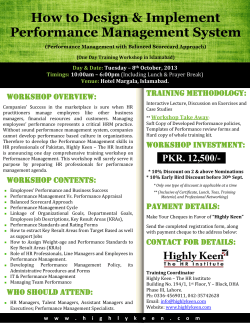
Biofertilizer Technology in Pakistan nutrients in Pakistan
Biofertilizer Technology in Pakistan Lab to Field: A success story of Biofertilizer Technology for crop nutrients in Pakistan Bio-fertilizers are suite of Plant Growth Promoting Rhizobacteria (PGPR) that enhance plant growth directly by providing mineral nutrients, mostly nitrogen (N), phosphorus (P), zinc (Zn), and other macroand micronutrients to plants. They also produce phyto hormones.These microbes act as biocontrol agents; promote growth indirectly by suppressing the deleterious effect of phyto-pathogens. “Nitragan” Rhizobia in 1985 in USA Azotobacter “Azotogen” in 1937 in Russia Extensive research since 1975 Azospirillum lipoferum inoculum “Azogreen” for maize inoculants in France 1994 Pakistan Bej ka tika, 1965, AARI Bio power,1996, NIBGE, PAEC Biozote, 1998, NARC Rice Biofert, UAF Humiphos, Biophos 2010, CIIT History of Biofertilizers Nitrogen fixation in Legumes 1978 Nitrogen fixation in Cereals 1979 Inoculum Production 1986 Azolla 1992 Growth Hormones 1994 Time travel with Microbes Biopower launching 1996 P-solubilization 1998 Bacteriocin Production 2001 Zn mobilization 2003 Biopesticides 2003 Ready to use Biofertilizer Humiphos/Biophos launching 2010 Achievements of scientists of PAEC & CIIT From the very beginning (1980s), IAEA through FAO/IAEA/Joint Division, Coordinated Research . projects (CRPs) and Technical Cooperation (TC/RC projects) department regularly and consistently complemented these efforts of scientists of Pakistan Atomic Energy Commission. At earlier stages the laboratory/ greenhouse studies were replicated in the micro field trials which were later extended to large field areas/ demonstration plots using different crops (cereals, cotton & legumes) grown on different soil types and agro-ecological conditions (irrigated, rain fed, saline affected soil etc.) to document the beneficial effects of these products. The use of N-15 stable isotopic dilution technique played a key role in the selection of efficient microbes and demonstrates their task in the field experiments in various cropping system in diverse ecological zones .These microbes have some host specificity; these PGPR fixed atmospheric nitrogen (% Ndfa) ranging from 11-59% on two rice varieties Bas-385 and Supper Basmati. At earlier stages the laboratory/ greenhouse studies were replicated in the micro field trials which were later extended to large field areas using different crops (cereals, cotton & legumes) grown on different soil types and agro-ecological conditions (irrigated, rain fed, saline affected soil etc.) to document the beneficial effects of these products Farmers visiting rice fields demonstration plots N-15 based chickpea field experiment under FAO/IAEA CRP project . Healthy nodules efficient in fixing atmospheric nitrogen Production / Outreach A pilot Biofertilizer assembly plant was also set up at National Institute for Biotechnology and Genetic Engineering (NIBGE) to deliver the technology for the benefits of end-users (farmers) under the name of BioPower (http//:www.nibge.org). Public sector leading research and academic organizations like COMSATS Institute of Information Technology (CIIT), National Agriculture Research Center (NARC), Ayub Agriculture Research Institute (AAR), University of Agriculture Faisalabad (UAF) in addition to Pakistan Atomic Energy Commission (PAEC) contributed in establishing and expanding this technology which was finally taken up by the private sector. The impact of these Biofertilizers drew the attention of entrepreneur and through public-private partnership (Humiphos & Biophos: phosphatic biofertilizers), this venture had acquired an industrial status.. IAEA delegation led by Director TCAP and Section head, SWMCN of NA department visiting pilot scale fermentation assembly of Biofertilizer production unit at NIBGE, Faisalabad, Pakistan Farmers attending awareness workshop on Bio-fertilizer The Government of Pakistan recently approved quality standards for the approval and monitoring of the commercial Bio-fertilizers. Six commercial Biofertilizers products are available in the market and gaining popularity among the farmers IAEA sponsored fellow from Tanzania learning lab techniques Dose and Application One bag per acre weighing about 1 KG is required for small seed crops and two bags per acre for large seed crops. Mode of application is simple. • Seedling root dip for rice, sugarcane and onion • Seed treatment for grain crops ½ NP+BP ½ NP+BP+Zn NP+Zn NP Dose / Application One bag (BioPower) per acre weighing about 1 kg is required for small seed crops and two bags per acre for large seed crops. Mode of application is simple. Seedling root dip for rice, sugarcane and onion Seed treatment for grain crops. Impact Healthy roots development & better nutrient uptake due to PGPR through Biofertilizer Biofertilizer is a premium quality supplemental inoculant for all crops, which enhances nutritional availability and produces superior yields. This rich blend of microbes works to revitalize the soil and feed the plant so the crop thrives Application of Biofertilizers promises the saving of half nitrogen and phosphorus fertilizers 20-30% yield increase in a range of crops. Improve soil structure/ fertility for sustainable agriculture Reduce soil born diseases Reduce environmental hazards of chemical fertilizer and pesticides Complex delivery chain of “Labs to Land” for R&D project appears successful.
© Copyright 2025

















